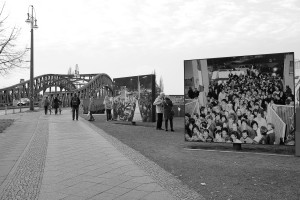
When the Berlin Wall was brought down on November 9th 1989, the most iconic part of the iron curtain suddenly opened. An event in the recent history that captivated people around the world. How did that happen? It was probably not David Hasselhoff’s hit single Looking for freedom that convinced the East German politicians to open the wall. Here a short overview of some of the occurrences.
40th anniversary German Democratic Republic
The German Democratic Republic (GDR) was established in 1949 and would celebrate its 40th anniversary in October 1989. A big opportunity for the republic to show the world its harmony and prosperity. In fact, the economic situation in East Germany was bad. Industries were old, shops were empty and without the help of the Soviets its future was hopeless.
Political changes in the surrounding Warsawpact countries such as Poland, Hungary and Czechoslovakia were not carried out by the East German SED regime. Together with the ongoing suppression by this dictatorial regime, it made more and more people felt hopeless and wanted to leave the state. The only thing that stopped them was a combination of concrete, barbed wires, border guards and the chance of being shot or at least convicted for years of imprisonment for high treason.
West German embassy in Prague
Many people tried to flee to the West via the Czechoslovakian and Hungarian border, these were easier to cross than the border with West Germany and these countries already opened their borders with western countries.
Since the summer of 1989 many people fled into the garden of the West German embassy in Prague, but the Czechoslovakian authorities did not allow their passage to West Germany without the permission of East Germany. Until October 10.000 people had accumulated in the embassy, and something had to be done. As the 40th anniversary of the GDR was approaching, the East German authorities gave in and the refugees were allowed to leave. Again, this made many East Germans to step into their Trabant and drive to Prague. In the days following more then 20.000 GDR citizens traveled via Czechoslovakia into West Germany.
Demonstrations
Meanwhile in East Germany more and more people stood up against the dictatorial regime. They demanded free elections and freedom to travel.
For about 10 years the Nikolai Church in Leipzig was the center of opposition against the GDR regime and organised peaceful gatherings. In 1989 it played a central role in organising weakly demonstrations, which became larger and larger.
The demonstrations overshadowed the 40th anniversary celebrations of th GDR on October 7th. While people were expected to watch the marches and sing about building their country for a better future, a few thousand people demonstrated. Special guest Soviet president Gorbachev, who understood that changes were necessary, did not interfere. A few days later another large demonstration in Leipzig was not stopped by the authorities and the Soviet troops did not interfere as well.
The regime had a wake-up call and understood that changes were necessary for the GDR to survive. Honecker was replaced by the new leader Egon Krenz, but the population did not believe it anymore. Demonstrations became larger than ever before. On November 8th more than 500.000 Berliners demonstrated at the Alexanderplatz.
New travel regulations
At 9 November in the early evening, SED politician Günter Schabowski announces new travel regulations at a press conference attended by the international press, live on television. On a question when these regulations would apply, Günter Schabowski speaks the famous words “sofort und unverzüglich” (immediately and without delay). He was confused. The new travel regulations should officially apply the next day and still visa would be reguired.
Bornholmer Strasse
At 20:00 just after the remarkable announcement, the first East Berliners gathered at the border crossing Bornholmer Strasse in order to cross the border and never come back. Or just to have a curious look into the free western part of the city. Now that they officially were allowed to travel, as heard on television.
As the border guards did not get any official orders, other than the announcement by Schabowski they saw live on television, they refused to let the citizens pass and tried to handle the situation.
In between the crowd became larger and larger. To keep the pressure down a few citizens were allowed to cross the border by getting a stamp on their passport photographs. This meant that they were expatriated would never to be able to get back into the GDR again. But the angry crowd did not stop yelling.
Fall of the Wall
It was just after 23:00 when East German border guard Harald Jäger realised that the situation could not be stopped and he ordered to open the gate. Without official permission. What had been unthinkable for many years did happen: The wall was open. That night more than 20.000 East Berliners crossed the border at Borhnolmer Strasse, excited, amazed, speechless, in tears, and celebrating, welcomed by West Berliners who also could not believe what just happened. The same emotional scenery occured at all other Berlin border crossings. From that moment Berlin was reunited and had a unique party to celebrate. At Brandenburger gate Berliners climbed on the Wall, which from that moment on was nothing more than just a piece of concrete instead of the division of a city for 28 years. Border guards could just watch.
The next day, people in almost every East German village applied for a travel visum. To travel into a new world, and into a new, unknown, and sometimes hard, future.
A peaceful revolution. Soviet leader Gorbachev could have sent some tanks to suppress the riots but he did not. Sadly, many people gave their lives during the 28 years before when they tried to flee just to be free.